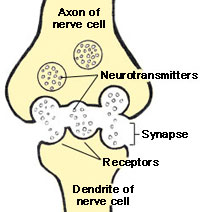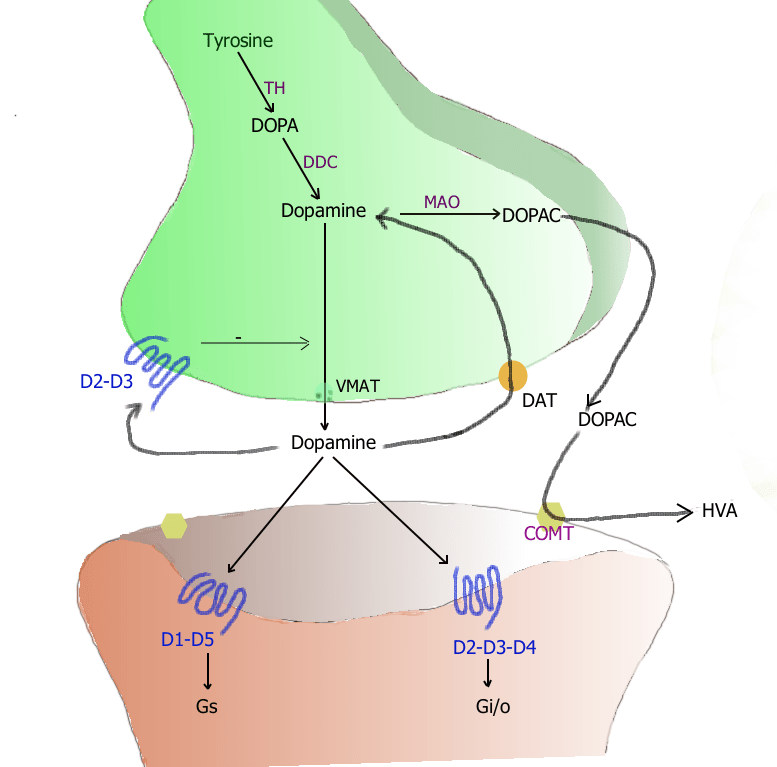Difference Between Neurotransmitter and Neuromodulator
Table of Contents
Key Difference – Neurotransmitter vs Neuromodulator
The key difference between neurotransmitter and neuromodulator is that neurotransmitter is a chemical substance released by the neuron to send signals to the next neuron, while the neuromodulator is a chemical substance released by the neuron to alter the effectiveness of the signal transmission. Neuromodulators can increase or decrease the signal transmission which happens through neurotransmitters by controlling the synthesis and the amount of neurotransmitters released in response to the stimuli.
CONTENTS
1. Overview and Key Difference
2. What is a Neurotransmitter
3. What is a Neuromodulator
4. Side by side Comparison – Neurotransmitter vs Neuromodulator
5. Summary
What is a Neurotransmitter?
Neurotransmitters are commonly found in the nervous system of living organisms. It is a chemical molecule released by the presynaptic neuron to transmit signals to the postsynaptic neuron or to a non-neuronal cell. There are different types of neurotransmitters associated with chemical synapses. Based on the size of the neurotransmitter, two main groups can be identified: small molecule neurotransmitters and large molecule peptides [neuropeptides]. Small molecule neurotransmitters are single amino acids, acetylcholine, amines, purines, etc. Neuropeptides are small protein molecules involved in the chemical synapses. Based on the action of the neurotransmitters, there are two main types; inhibitory neurotransmitters and excitatory neurotransmitters. Excitatory neurotransmitters stimulate the brain while inhibitory neurotransmitters balance and calm the brain.
Neurotransmitters are synthesized in the soma or at the axon terminal of the presynaptic neuron and stored inside the small sacs called synaptic vesicles. Synaptic vesicles filled with neurotransmitters are then released into the space between two neurons which is known as synaptic cleft. Vesicle membrane fuses with the plasma membrane of the neuron and exposes the neurotransmitters to the synaptic cleft by exocytosis. Neurotransmitters diffuse through the synaptic cleft and find their specific receptors at the plasma membrane of the postsynaptic neuron. Some neurotransmitters are quickly recycled by the presynaptic neuron and some are degraded by the enzymes. Neurotransmitters bound to the receptors, transmit the chemical signal to next neuron. This transmission happens rapidly since they bind with ionotropic receptors.
Well, known neurotransmitters include Acetylcholine, Glutamine, Glutamate, Serine, Glycine, Alanine, Aspartate, Dopamine, etc.

Figure_1: Chemical Synapse
What is a Neuromodulator?
Neuromodulator is a chemical molecule, which is capable of changing the effect of impulse transmission on neurons without disturbing the rate of the transmission. It happens through the control of neurotransmitters synthesis and release. Neuromodulators are produced by neurons. They are available in a wide area of the nervous system. The action of a neuromodulator is not restricted to a particular neuron or to the site of released. It can be effective in several or groups of neurons or target cells. Neuromodulators bind with metabotropic receptors, mainly G protein activated receptors. They activate a new molecule called secondary messenger. Neuromodulation is a slow and long-lasting process since it involves metabotropic receptors.
Common neuromodulators in the central nervous system are dopamine, serotonin, acetylcholine, histamine, and norepinephrine.

Figure_2: Dopamine processing in a synapse
What is the difference between Neurotransmitter and Neuromodulator?
Neurotransmitter vs Neuromodulator | |
| Neurotransmitter is a chemical substance released by the neuron to send signals to the next neuron. | Neuromodulator is a chemical substance released by the neuron to alter the effectiveness of the signal transmission. |
| Role | |
| Its role is the transmission of chemical signals to the adjacent neuron. | Its role is to alter the signal transmission of neurons by controlling the neurotransmitter synthesis and release. |
| Releasing Site | |
| Neurotransmitters are released into the synaptic cleft. | Neuromodulators can be released to any area of the neuron. |
| Binding Receptors | |
| They bind to ionotropic receptors. | They bind with metabotropic receptors and activate secondary molecules. |
| Action | |
| They act on one presynaptic neuron or an effector cell. | They are effective on groups of neurons. |
| Speed of Action | |
| They are moderately fast. | They are moderately low and last for longer periods. |
| Reuptake | |
| Presynaptic neurons can reabsorb the neurotransmitter. | They are not reabsorbed by the presynaptic neuron. |
Summary – Neurotransmitter vs Neuromodulator
Neurotransmitters are the chemical molecules that carry the chemical signals from one neuron to the next neuron and facilitate the signal transmission through neurons. Neuromodulators are the substances released to change the cellular or synaptic properties of neurons and alter the signal transmission that happens through neurotransmitters.This is the key difference between neurotransmitter and neuromodulator. Neurotransmitters bind to the ionotropic postsynaptic receptors and quickly pass the signal while the neuromodulators bind with metabotropic receptors of the postsynaptic neurons and slowly modulate the signal transmission of a group of neurons or effector cells.
Reference:
1. “Neurogistics.” What are Neurotransmitters? – Neurogistics. N.p., n.d. Web. 07 Feb. 2017
2. “Neuromodulation of neurons and synapses.” Current opinion in neurobiology. U.S. National Library of Medicine, n.d. Web. 07 Feb. 2017
3. “Neuromodulation.” Wikipedia. Wikimedia Foundation, n.d. Web. 07 Feb. 2017.
4. Picciotto, Marina R., Michael J. Higley, and Yann S. Mineur. “Acetylcholine as a neuromodulator: cholinergic signaling shapes nervous system function and behavior.” Neuron. U.S. National Library of Medicine, 04 Oct. 2012. Web. 07 Feb. 2017.
Image Courtesy:
1. “Chem. Synapse scheme” By (Public Domain) via Commons Wikimedia
2. “Synapse dopaminergique” By Pancrat – Own work (CC BY-SA 3.0) via Commons Wikimedia
ncG1vNJzZmivp6x7pbXFn5yrnZ6YsqOx07CcnqZemLyue8OinZ%2Bdopq7pLGMm5ytr5Wau266xK6pqKyilru0ucitq56qXZa7pXnVrGSnnaWnvK67w66jmqyfp3w%3D